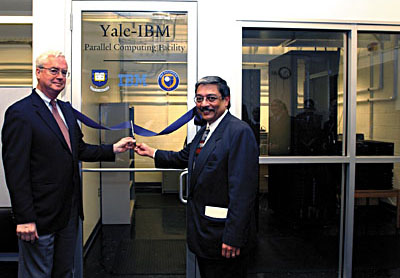 | Yale Engineering Dean Paul A. Fleury (left) and Tilak Agerwala of IBM cut the ribbon to the new Yale-IBM computer center. |
A ribbon-cutting ceremony for a collaborative Yale-IBM Parallel Computing Facility was held on April 27 in Becton Engineering and Applied Science Center.
The ceremony represented the culmination of conversations that began in October of 2001 between IBM and Yale Engineering on how to foster an enhanced research relationship between the two institutions. IBM contributed equipment to Yale under its Shared University Research grant program, and this dedication marked the official opening of the computing facility.
The powerful cluster of interconnected computing systems provides Yale a cost-effective platform for high performance computing. Application of this computing cluster may lead to future experiments with IBM's Blue Gene technology, the basis for the world's most powerful supercomputer.
"This collaboration and shared resource gives us at Yale a real step up in our on-site computer capability. It will have a tremendous impact for programs in engineering and physics," said Paul A. Fleury, dean of Yale Engineering, in his opening remarks.
"Computational sciences and cost-effective supercomputing have become fundamental to innovation and discovery in science, engineering and business," said Tilak Agerwala, vice president of Systems at IBM Research. "Yale is following the right paradigm with this IBM cluster."
Mitchell D. Smooke, the Strathcona Professor of Mechanical Engineering, said that one project the researchers will focus on involves modeling improvements for combustion in automobiles -- noting that people are likely to be driving cars using derivative hydrocarbon fuel for the next 50 to 100 years in spite of new innovations. Modeling with high-performance computing of the type installed in the Yale-IBM facility could lead to significant reductions in emissions and improvements in fuel economy, he said.
Ramamurti Shankar, chair of the Department of Physics and the John Randolph Huffman Professor of Physics, said his colleagues will use the system to test models of the underlying "theory of everything," also known as "string theory," which at the moment has no direct evidence.
"Having this very powerful computer will allow us to use the basic rules of physics that we know, but cannot test directly, to test the theories," he said.
-- By Janet Rettig Emanuel
T H I S
Yale-IBM computer facility formally dedicated W E E K ' S
W E E K ' S S T O R I E S
S T O R I E S![]()
 Team creates blood test for 'silent killer'
Team creates blood test for 'silent killer'![]()
![]()
 University marks 100 years of 'Pomp and Circumstance'
University marks 100 years of 'Pomp and Circumstance'![]()
![]()
 Yale scientist featured in new stamp series
Yale scientist featured in new stamp series![]()
![]()
 Twelve honored for strengthening town-gown ties
Twelve honored for strengthening town-gown ties![]()
![]()
 ENDOWED PROFESSORSHIPS
ENDOWED PROFESSORSHIPS Two appointed to Sterling chairs
Two appointed to Sterling chairs![]()
 R. Howard Bloch: French and Medieval Studies
R. Howard Bloch: French and Medieval Studies![]()
 Ian Shapiro: Political science and YCIAS
Ian Shapiro: Political science and YCIAS![]()
 Romano named Ruebhausen Professor
Romano named Ruebhausen Professor![]()
 Waxman is appointed to Flaherty chair
Waxman is appointed to Flaherty chair![]()
 Dr. State has been designated Harris Assistant Professor . . .
Dr. State has been designated Harris Assistant Professor . . .![]()
![]()
 Krauss named to second term at Silliman
Krauss named to second term at Silliman![]()
![]()
 Researchers discover virus' potential to target and kill deadly brain tumor
Researchers discover virus' potential to target and kill deadly brain tumor![]()
![]()
 Yale professors endow teaching and research fund in the history of science
Yale professors endow teaching and research fund in the history of science![]()
![]()
 Study shows, when it comes to fish genitalia, size has pros and cons
Study shows, when it comes to fish genitalia, size has pros and cons![]()
![]()
 Two Yale scientists honored with election to the NAS
Two Yale scientists honored with election to the NAS![]()
![]()
 Six Yale affiliates elected fellows of scholarly society
Six Yale affiliates elected fellows of scholarly society![]()
![]()
 Beijing conference explored Chinese constitutionalism
Beijing conference explored Chinese constitutionalism![]()
![]()
 New scholarship will help nurture future activist ministers
New scholarship will help nurture future activist ministers![]()
![]()
 Yale-IBM computer facility formally dedicated
Yale-IBM computer facility formally dedicated![]()
![]()
 REUNIONS
REUNIONS Alumni will gather for talks, tours and other special events
Alumni will gather for talks, tours and other special events![]()
 Library exhibit celebrates the accomplishments of the Class of '55
Library exhibit celebrates the accomplishments of the Class of '55![]()
 Medical school reunions feature talks on cutting-edge research
Medical school reunions feature talks on cutting-edge research![]()
![]()
 Yale launches research on lung cancer . . .
Yale launches research on lung cancer . . .![]()
![]()
 Workshop will explore technology's power to capture . . .
Workshop will explore technology's power to capture . . .![]()
![]()
 Show features artist's colorful depictions of 'Northern Shores'
Show features artist's colorful depictions of 'Northern Shores'![]()
![]()
 Glen Micalizio wins Beckman Young Investigator award . . .
Glen Micalizio wins Beckman Young Investigator award . . .![]()
![]()
 IN MEMORIAM
IN MEMORIAM Benjamin Mordecai: Drama school teacher and Broadway producer
Benjamin Mordecai: Drama school teacher and Broadway producer![]()
 Memorial service to honor South African historian Leonard Thompson
Memorial service to honor South African historian Leonard Thompson![]()
![]()
 Campus Notes
Campus Notes![]()
Bulletin Home |
| Visiting on Campus
Visiting on Campus |
| Calendar of Events
Calendar of Events |
| In the News
In the News![]()
Bulletin Board |
| Classified Ads
Classified Ads |
| Search Archives
Search Archives |
| Deadlines
Deadlines![]()
Bulletin Staff |
| Public Affairs
Public Affairs |
| News Releases
News Releases |
| E-Mail Us
E-Mail Us |
| Yale Home
Yale Home